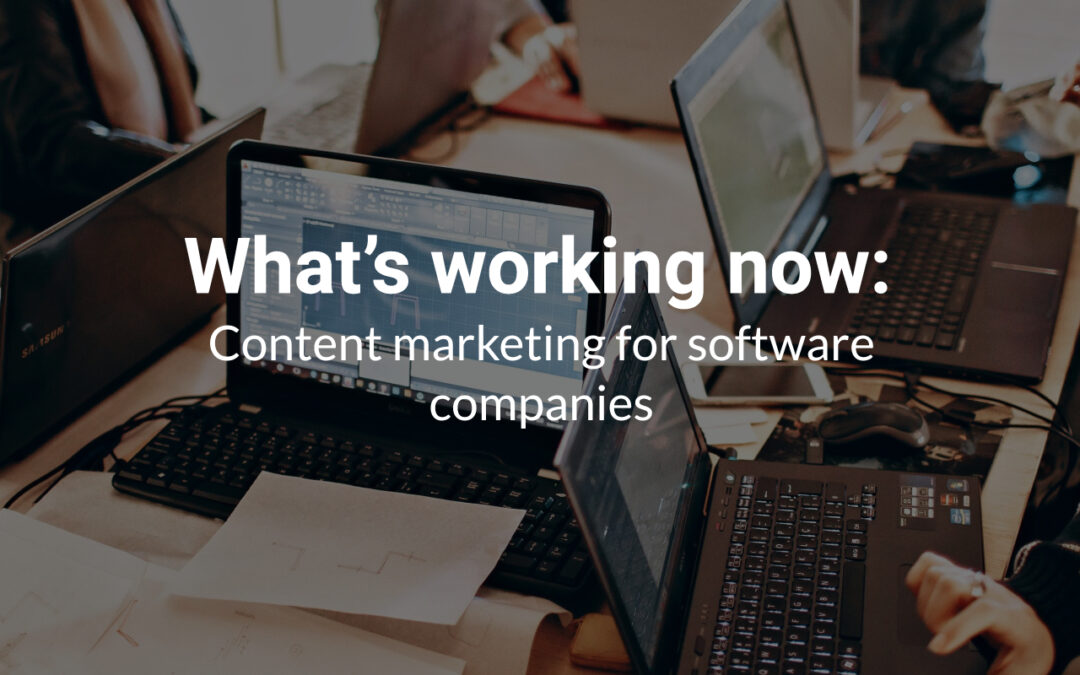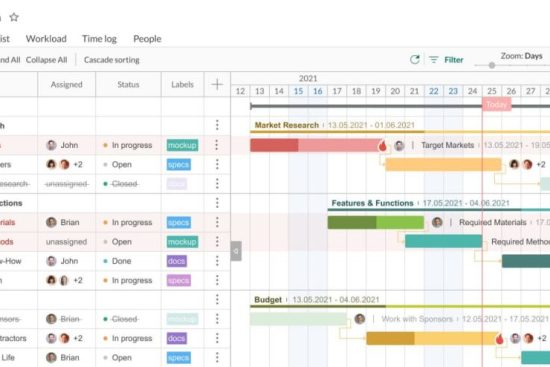
Content marketing can transform software companies. It helps attract and engage users effectively.
Software companies face intense competition. Standing out requires more than just a great product. Content marketing offers a powerful way to connect with your audience. By sharing valuable insights, you build trust and authority. This blog will explore how content marketing can benefit software companies.
We’ll look at strategies to create compelling content that resonates with your target audience. Whether you are a startup or an established company, mastering content marketing can drive growth and success. Ready to learn how? Let’s dive in and discover the key elements that make content marketing a game-changer for software companies.

Credit: contentmarketinginstitute.com
Introduction To Content Marketing
Content marketing is vital for software companies. It helps in educating potential clients, building trust, and showcasing expertise. With the right strategies, software companies can generate leads and foster customer loyalty.
Importance In Software Industry
The software industry is highly competitive. Companies need to stand out to attract customers. Content marketing helps in achieving this. It provides valuable information to potential clients. This builds trust and positions the company as an expert.
Quality content can answer questions, solve problems, and explain complex software features. This can make the buyer’s journey smoother. It also reduces the burden on customer support teams. Engaging content can include:
- Blog posts
- Case studies
- Whitepapers
- Webinars
- Tutorial videos
Current Trends
Several trends are shaping content marketing in the software industry. One key trend is the use of video content. Videos can demonstrate software features in action. They are engaging and easy to understand. Another trend is the rise of interactive content. Interactive content includes quizzes, polls, and calculators.
Personalization is also becoming important. Personalized content can target specific customer segments. It can address their unique needs and challenges. Data-driven content is another trend. It uses analytics to create relevant and timely content.
| Trend | Benefits |
|---|---|
| Video Content | Engaging, easy to understand, demonstrates features |
| Interactive Content | Engages users, makes content fun |
| Personalization | Targets specific segments, addresses unique needs |
| Data-driven Content | Relevant, timely, based on analytics |
Setting Clear Goals
Content marketing for software companies needs clear goals. Goals guide your strategy. They help measure progress. Without goals, your efforts may go to waste. Clear goals ensure your content aligns with your business aims.
Defining Objectives
First, define your objectives. What do you want to achieve? Increase website traffic? Generate leads? Boost brand awareness? Each objective shapes your content strategy. Make sure your objectives are specific. Vague goals lead to vague results. Specific goals lead to clear action steps.
Measuring Success
Next, decide how to measure success. Use key performance indicators (KPIs) to track progress. For website traffic, check page views and unique visitors. For lead generation, track form submissions or sign-ups. Clear metrics show if you are on the right path. Regularly review these metrics. Adjust your strategy as needed.
Understanding Your Audience
Understanding your audience is crucial for effective content marketing. Software companies need to tailor their content to meet the needs and interests of their audience. By knowing who your audience is, you can create content that speaks directly to them. This helps in building trust and engagement.
Identifying Target Audience
Start by identifying your target audience. Who are your potential customers? Are they business professionals, tech enthusiasts, or casual users? Determine their demographics such as age, gender, job title, and location. This information helps in creating relevant content.
Understand their pain points. What problems do they face that your software can solve? Knowing their challenges allows you to address them in your content. This makes your content valuable and relevant.
Creating Buyer Personas
Creating buyer personas is a key step. A buyer persona is a fictional representation of your ideal customer. It includes details like age, job role, goals, and challenges. This helps in personalizing your content.
Give your personas names and backgrounds. This makes them more relatable. For example, “Techie Tom” could be a young software developer seeking new tools. Tailor your content to address Tom’s specific needs and interests.
Use data to refine your personas. Collect feedback from your sales team, customer service, and social media. This ensures your personas are accurate and up-to-date.

Credit: www.horizonpeakconsulting.com
Content Creation Strategies
Content creation strategies are crucial for software companies. Effective content attracts and engages potential customers. Different types of content serve unique purposes. Let’s explore three key content types: Blog Posts, Case Studies, and Whitepapers.
Blog Posts
Blog posts are vital for content marketing. They help you share valuable information. Blog posts can cover a range of topics. Share insights about industry trends. Discuss software features and benefits. Address common customer problems. Provide solutions. Blog posts are great for SEO. Use relevant keywords. Keep content fresh and regular. Engage readers with interactive content. Encourage comments and discussions.
Case Studies
Case studies showcase your success stories. They highlight real-world applications of your software. This content builds trust and credibility. Detail the problem your customer faced. Explain your solution. Show the results achieved. Use data and statistics. Keep the narrative engaging and concise. Include customer testimonials. Visual aids like graphs and charts can enhance understanding.
Whitepapers
Whitepapers are in-depth reports. They provide detailed information on complex topics. Use whitepapers to establish authority. Share comprehensive research and analysis. Address industry challenges and trends. Offer solutions and recommendations. Whitepapers attract serious prospects. They prefer detailed and technical content. Include visuals and charts. Make the information easy to digest.
Seo Best Practices
Effective content marketing for software companies requires a solid grasp of SEO best practices. These practices help increase visibility and attract potential customers. Let’s explore some key strategies to optimize your content for search engines.
Keyword Research
Keyword research is essential for SEO success. Begin by identifying relevant keywords that your target audience uses. Use tools like Google Keyword Planner or Ahrefs to find popular search terms.
| Tool | Purpose |
|---|---|
| Google Keyword Planner | Identify popular keywords |
| Ahrefs | Analyze keyword difficulty |
Create a list of primary keywords and secondary keywords for your content. Focus on long-tail keywords. They have lower competition and higher conversion rates.
- Identify keywords with high search volume
- Analyze competitors’ keywords
- Use long-tail keywords
On-page Optimization
On-page optimization involves improving elements within your website. Ensure your content is well-structured and easy to read.
- Use target keywords in titles and headings
- Write meta descriptions that include primary keywords
- Ensure URL structure is clean and keyword-rich
Utilize header tags (H1, H2, H3) to structure your content. This makes it easy for search engines to understand your content.
Main Title
Subheading
Sub-subheading
Optimize images with alt text that includes relevant keywords. Compress images to improve page load speed.
- Use descriptive alt text for images
- Compress images for faster loading
Implementing these SEO best practices can help software companies increase visibility. This attracts more potential customers. Stay updated with SEO trends for ongoing success.
Social Media Promotion
Social media promotion is vital for software companies. It helps reach a broad audience and builds brand awareness. By using social media, software companies can engage with users and show their expertise.
Platform Selection
Choosing the right social media platform is crucial. Different platforms attract different users. Here is a simple table that outlines the main features:
| Platform | Audience Type | Best For |
|---|---|---|
| General Public | Community Building | |
| Professionals | B2B Networking | |
| Tech Enthusiasts | Real-Time Updates | |
| Younger Audience | Visual Content |
LinkedIn is excellent for professional networking. Facebook is ideal for community engagement. Twitter works well for quick updates. Instagram is perfect for sharing visual content.
Engagement Tactics
Engaging with your audience is key. Here are some effective tactics:
- Respond to comments: Show you value feedback.
- Share user-generated content: Build trust and community.
- Post consistently: Keep your audience engaged.
- Use visuals: Images and videos boost engagement.
Regularly respond to user queries. Share success stories and testimonials. Create polls and surveys to involve users. Use analytics to understand what works best. Focus on quality over quantity.
In summary, platform selection and engagement tactics are vital. Use the right platform and engage effectively. This will help your software company grow through social media promotion.
Email Marketing Campaigns
Email marketing campaigns are essential for software companies looking to engage with their audience. These campaigns help in promoting new features, updates, and services. They also build strong customer relationships and drive user retention.
Building Email Lists
Building a quality email list is the foundation of a successful email marketing campaign. Start by ensuring you have a clear call-to-action (CTA) on your website. Offer something valuable in return for visitors’ email addresses. This could be a free trial, a discount, or an informative eBook.
Use signup forms on your homepage, blog, and landing pages. These forms should be simple and require only essential information. This makes it easier for users to subscribe. Consider using pop-ups or slide-ins for increased visibility without being intrusive.
Segment your email lists based on user behavior and preferences. This helps in sending targeted emails that are more likely to be relevant and engaging.
Crafting Effective Emails
Creating effective emails is crucial for the success of your campaigns. Start with a compelling subject line. This is the first thing your recipients will see. Keep it short, clear, and enticing. Avoid using spammy words or excessive punctuation.
The body of your email should be concise and to the point. Use bullet points and subheadings to make the content easy to read. Highlight the key benefits of your message.
Personalize your emails by using the recipient’s name and tailoring the content to their interests. This increases engagement and makes the email feel more relevant. Include a clear and persuasive call-to-action. This guides the recipient on what to do next.
Ensure your emails are mobile-friendly. Many users read emails on their smartphones. Use responsive design to make sure your emails look good on all devices.
Below is a simple table to show the key elements of effective emails:
| Element | Description |
|---|---|
| Subject Line | Short, clear, and enticing |
| Email Body | Concise, with bullet points and subheadings |
| Personalization | Use recipient’s name and tailor content |
| Call-to-Action | Clear and persuasive |
| Mobile-Friendly Design | Responsive design for all devices |
Analyzing And Adapting
Analyzing and adapting are key components of content marketing for software companies. Understanding the performance of your content and making necessary adjustments can lead to better engagement and conversion rates. Let’s explore how you can track performance and iterate strategies to optimize your content marketing efforts.
Tracking Performance
Tracking performance is crucial for content marketing success. To start, set clear goals. These might include:
- Increased website traffic
- Higher conversion rates
- More social media engagement
- Improved customer retention
Use tools like Google Analytics, SEMrush, and Ahrefs to gather data. Focus on key metrics such as:
| Metric | Description |
|---|---|
| Page Views | Number of times a page is viewed. |
| Bounce Rate | Percentage of visitors who leave after viewing one page. |
| Average Session Duration | Average time users spend on your site. |
| Conversion Rate | Percentage of visitors completing a desired action. |
Regularly review these metrics. Identify patterns and areas needing improvement. Adjust your content strategy accordingly.
Iterating Strategies
Iterating strategies involves making small, continuous improvements. Start by identifying which content performs well. This content can serve as a model for future efforts. Consider the following steps:
- Analyze successful content.
- Identify common elements.
- Replicate these elements in new content.
- Test different formats and styles.
- Collect feedback from your audience.
For example, if blog posts with infographics perform well, create more infographics. If detailed tutorials get high engagement, produce more of them.
Involve your team in the iterative process. Encourage brainstorming and idea sharing. Keep track of all changes and their outcomes. This way, you can see what works and what doesn’t. Over time, this approach will refine your content marketing strategy, making it more effective.
Case Studies And Success Stories
Content marketing is crucial for software companies. Through real-life examples, software companies can learn what worked and what did not. This helps them to craft their own content marketing strategies. In this section, we will delve into successful campaign examples and key lessons learned.
Successful Campaign Examples
HubSpot stands as a beacon in content marketing. They used educational content to attract and retain customers. Their blog offers a wide range of topics, from marketing tips to CRM tools. This approach helped them build trust and authority.
Slack also succeeded through unique content. Their blog and social media focus on productivity and teamwork. They share real-life stories and user testimonials. This content resonates with their audience.
Another example is Mailchimp. They use interactive guides and tutorials to engage users. These guides help users understand email marketing better. This strategy boosts user engagement and loyalty.
Lessons Learned
Case studies teach us valuable lessons. Here are a few:
- Consistency is key: Regular updates keep the audience engaged.
- Quality over quantity: High-quality content builds trust.
- Know your audience: Tailor content to meet their needs.
In essence, content marketing for software companies involves a clear strategy. Learning from these case studies can help refine your approach.
Future Trends In Content Marketing
The future of content marketing holds many exciting changes for software companies. As technology evolves, so do the strategies and tools in content marketing. Staying ahead of these trends can give companies a competitive edge. Let’s explore some of these future trends.
Emerging Technologies
Artificial Intelligence (AI) will play a significant role. AI can analyze vast amounts of data quickly. This helps in creating personalized content. Machine learning algorithms can predict user behavior. This allows for more targeted marketing campaigns.
Virtual Reality (VR) is another emerging technology. VR can offer immersive experiences to users. Imagine a virtual tour of your software’s features. This can engage users like never before.
Predicted Changes
User-generated content will become more important. People trust content from other users. Encouraging reviews and testimonials can boost credibility. It also creates a sense of community.
Interactive content will see a rise. Quizzes, polls, and interactive infographics engage users better. They provide value and are more memorable. This can increase user interaction with your brand.
Voice search will gain popularity. Optimizing content for voice search is vital. People use voice assistants to find information. Ensuring your content is voice-search friendly is crucial.
Short-form video content is on the rise. Videos are more engaging than text. They can convey messages quickly. Creating short, informative videos can capture the audience’s attention.

Credit: foundationinc.co
Frequently Asked Questions
What Is Content Marketing For Software Companies?
Content marketing for software companies involves creating valuable content to attract, engage, and retain customers. It includes blogs, videos, case studies, and whitepapers.
Why Is Content Marketing Important For Software Companies?
Content marketing builds brand awareness, generates leads, and educates potential customers. It helps software companies showcase their expertise and solutions effectively.
How Can Software Companies Create Engaging Content?
Software companies can create engaging content by understanding their audience’s needs. They should provide valuable insights, use storytelling, and include visuals.
What Types Of Content Are Best For Software Companies?
Blogs, case studies, whitepapers, videos, and webinars work best. These formats help explain complex software solutions clearly and engage the audience.
Conclusion
Content marketing boosts software companies’ growth. Focus on creating valuable, relevant content. Engage your audience consistently. Build trust through informative blogs, videos, and social media posts. Measure success with analytics. Adapt strategies based on feedback. Stay updated with industry trends.
Your efforts will pay off with increased visibility and customer loyalty. Remember, quality content connects and converts. Start today, and see the difference.

